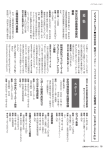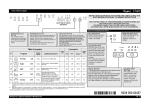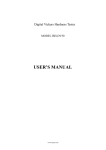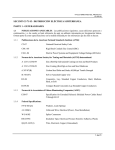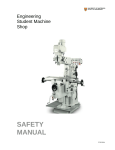Download Instructions for use GCX 5582
Transcript
Instructions for use GCX 5582 Bauknecht AG, Industriestrasse 36, 5600 Lenzburg, www.bauknecht.ch Verkauf Kundendienst Ersatzteile Telefon 0848 801 002 Telefon 0848 801 001 Telefon 0848 801 005 Fax 0848 801 017 Fax 0848 801 003 Fax 0848 801 004 [email protected] [email protected] [email protected] 4GB96001.fm Page 1 Wednesday, September 8, 2004 5:27 PM Before using the dishwasher, read the user instructions! GB Quick Reference Guide GCX 5582 D S On/Off button Press the ON button to switch on the dishwasher. The indicator lamp of the last programme selected lights up; at the end of the cycle an acoustic signal sounds. Additional options in case of failure Indicators Off Programme selection button Press the button to select a programme. The corresponding indicator lamp lights up. Blinking On Indicators Water stop device activated Switch off the dishwasher and contact the After-sales Service. Add regeneration salt Only add regeneration salt immediately before starting a wash programme. The dishwasher over fills with water Reset and start the programme again from the beginning. If the problem persists, contact the After-Sales Service. Add rinse aid The water heating system is not working Reset and start the programme again from the beginning. If the problem persists, contact the After-Sales Service. Additional option “Delayed start” button Water temperature sensor fault Reset and start the programme again from the beginning. If the problem persists, contact the After-Sales Service. The wash cycle can be programmed to start after 3-6-9 hours. Press button (D) to select the delayed start. The corresponding indicator lamp (S) lights up. The dishwasher will start at the set time. To quit selection and start the wash program without the delayed start, press button (D) until the 3-6-9 indicator lamps switch off. The dishwasher does not fill with water Check the water supply and filters, and make sure that there are no kinks in the water inlet hose. Open and close the door in order to continue. The dishwasher does not drain Make sure that the filter unit and drain hose are not clogged and if necessary clean them. Programme chart Programmes 2) Loading instructions Consumption 3) A B Litres kWh Minutes - - 5.0 0.02 9 Pre-Rinse cold Rapid soiled crockery with no dried-on 45°C Lightly food. X - 12.0 0.90 59 Eco 1) 50°C Normally soiled crockery. X - 13.0 1.01 125 Normal 65°C Normally or heavily soiled crockery. X X 16.0 1.26 85 X X 20.0 1.45 100 Intensive 1) Detergent 2) 70°C Crockery to be washed later. Recommended programme for heavily soiled crockery, especially suitable for pans and saucepans. Reference programme for energy label in compliance with EN 50242 regulations; Refer to “User instructions”; 3) Program data obtained in conformity with European standard EN 50242. Values may vary in relation to usage, e.g.: different loads, water temperatures - above or below 15°C - as well as water hardness and power supply voltage, etc. 5019 496 96001 (We reserve the right to make technical modifications) Black process 45.0° 100.0 LPI 4GB96001.fm Page 2 Wednesday, September 8, 2004 5:27 PM How to use the appliance Further indications are given in the single chapters and in the user instructions. Open the door, switch on the appliance Press the On/Off button . Large compartment A C B A How to fill the detergent dispenser Small compartment B: Check the rinse aid level Mechanical indicator C. Electric indicator on control panel (if provided). Check the regeneration salt level On models with water softener system only. Mechanical indicator D. Electric indicator on control panel (if provided). Load the racks Refer to the dishwasher loading instructions. Select a programme Select additional options Press the button until the desired programme lights up. If necessary (and if provided). The corresponding indicator lamp lights up. “Cancel” Close the door to start the programme D Open the door, press until the indicator lamps 4 + 5 light up. Close the door, after about 1 min. the cycle ends. “Change programme in progress” Open the door. Select another programme and close the door in order to start the new cycle. Turn on the water tap Wash cycle - Only open the dishwasher if necessary (Warning: beware of hot steam). - If the appliance is switched off during a wash cycle, when switched on again it will resume the cycle from where it was interrupted. Switch off the appliance At the end of the programme an acoustic signal will sound. Open the door and press the On/Off button . All the indicator lamps switch off. Turn off the water tap, unload the racks Warning: When the door is opened steam comes out! Unload the appliance, starting from the lower rack. Black process 45.0° 100.0 LPI 4GB96001.fm Page 3 Wednesday, September 8, 2004 5:27 PM Dishwasher loading instructions and racks provided Upper rack: Crockery holder (A): Depending on the position: up or down: Long-handled utensils, cups and glasses. Place the glasses to the side of the rack or holders. Place long and narrow utensils in the centre of the rack or holders. Long-handled utensils (e.g. carving forks, knives) must be arranged with the sharp end facing in towards the appliance. depending on the model A A A A Rack height adjustment: Release the caps (B) of both rack rails. Take the rack out. Reposition the rack at the desired height. Close the caps (B). The rack must be level on both sides. B B Lower rack: Depending on the model with fixed or tilting plate holders. Cutlery basket: Some models are provided with a grid (C) that can be fitted onto the cutlery basket to keep items separated. Sharp knives and forks that might cause injury must be placed in the cutlery basket with the sharp end facing downwards. C C C C Only use dishwasher-proof crockery and dishes. Do not use the appliance for items not suitable for washing in a dishwasher, for example wooden items, aluminium, plastic utensils, tin, hand-decorated crockery (unglazed), silver cutlery. Black process 45.0° 100.0 LPI 4GB96001.fm Page 4 Wednesday, September 8, 2004 5:27 PM What to do if... If a fault occurs, before contacting our After-Sales Service, make the following checks to try and remedy the problem (* see also the corresponding chapter in the user instructions). Problem The appliance is not working If crockery is not perfectly dry If crockery is not perfectly clean Cause Remedy • No water supply. • Open the tap. • The appliance does not load sufficient water. • Clean the water supply tap filter. • Ensure there are no kinks in the water hose. • There is a power failure. • • • • • Insufficient rinse aid. • Increase dosage *. • Residual water in cavities. • Load crockery at an angle. • The water jet does not reach the crockery. • Arrange crockery so that items do not touch each other. Load crockery upside down. • Insufficient detergent. • Follow recommended detergent dosage. • Unsuitable programme. • Select a more intense wash cycle. • Spray arms blocked. • The spray arms must be able to turn freely. • Spray arm nozzles clogged. • Remove any impurities obstructing the water flow *. Insert the plug into the mains socket. Open the door. Close the door. Check the domestic circuit fuse. • Incorrect detergent/detergent too old. • Use a good quality detergent. Sandy or grainy residues • Clogged filters. • Check filters regularly/if necessary clean *. • Filters incorrectly assembled. • Insert the filter correctly *. • Tomato/carrot juice,... • Depending on the material, if necessary use a detergent with a greater whitening power. • Streaks on the crockery/glasses. • Reduce the rinse aid dosage *. • Layer of salt on crockery/glasses. • Close the salt container lid properly *. • Insufficient water softening, calcium deposits. • Change water hardness setting, if necessary add salt *. Opaque glasses/ glasses not sparkling • Cannot be washed in the dishwasher. • Use suitable glasses. Rust on cutlery • Not made of stainless steel. • Use suitable cutlery. Colour of plastic parts faded Deposits on crockery • removable • not removable If after carrying out the above checks the malfunction persists or appears again, turn the appliance off and turn off the water supply tap, then call our After-Sales Service (see guarantee). Before contacting our After-Sales Service, take note of the following: • The nature of the fault. • The appliance type and model. • The service code (the number indicated on the adhesive rating plate) inside the door on the right-hand side. Black process 45.0° 100.0 LPI . 4gb94602.fm Page 11 Tuesday, January 21, 2003 10:27 AM Instructions for use Before using the dishwasher/Connections Electrical connection Precautions and general recommendations How to fill the salt container How to fill the rinse aid dispenser How to fill the detergent dispenser Care and maintenance 11 Black process 45.0° 100.0 LPI 4gb94602.fm Page 12 Tuesday, January 21, 2003 10:27 AM Before using the dishwasher/Connections 1. Removing the packaging and controls: After unpacking, make sure that the dishwasher is undamaged and that the door closes correctly. If in doubt, contact a qualified technician or your local retailer. • Keep the packaging materials (plastic bags, polystyrene parts, etc.) out of reach of children, as they are potentially dangerous. • This dishwasher has been factory tested to ensure it functions correctly. Such testing may leave slight water marks that will disappear with the first wash. 2. Water and electrical connections: All water and electrical connections must be carried out by a qualified technician in compliance with the manufacturer's instructions (refer to the enclosed installation booklet) and current local safety regulations. The appliance must only be used in the household for the prescribed uses. Do not use the dishwasher if it has been damaged in transit. Consult your local retailer or our After-Sales Service. (Refer to the separate installation instructions booklet) 3. Water inlet and drain: • Observe any special regulations issued by your local Water Board. Water supply pressure: 0.3 - 10 bar. 12 Black process 45.0° 100.0 LPI • • • • • • Make sure the inlet and drain hoses are kink-free and are not crushed. If the hose length is not sufficient, please contact your local dealer or our AfterSales Service. The inlet hose must be securely clamped to the water tap to prevent leaks. The inlet water temperature varies according to the model installed. Inlet hose marked “25°C Max”: maximum temperature 25°C. All other models: maximum temperature 60°C. When installing the appliance, make sure the drain water discharges correctly (if necessary, remove the wire gauze from the sink siphon). Fix the drain hose to the spigot with a clamp to prevent it from coming off during operation. For appliances with waterstop system only: if the water connections are made correctly, the water-stop system safeguards your home against damage caused by flooding. 4. Electrical connection: • Closely adhere to local Electricity Board regulations. • Voltage information is shown on the rating plate mounted inside the door on the right hand side. • The appliance must be earthed as prescribed by law. • Do not use extension leads or multiple adapters. • Before carrying out maintenance, disconnect the mains plug. • If necessary, the power cable may be replaced with one the same obtained from our After-Sales Service. The power cable must only be replaced by a qualified technician. • For Austria: if the apparatus is series connected to a fault current switch, this must be sensitive to the pulsating current. 4gb94602.fm Page 13 Tuesday, January 21, 2003 10:27 AM Electrical connection 1) For Great Britain only 2) For the Republic of Ireland only Warning - this appliance must be earthed The information given in respect of Great Britain will frequently apply, but a third type of plug and socket is also used, the 2-pin, side earth type. Fuse replacement If the mains lead of this appliance is fitted with a BS 1363A 13amp fused plug, to change a fuse in this type of plug use an A.S.T.A. approved fuse to BS 1362 type and proceed as follows: 1. Remove the fuse cover (A) and fuse (B). 2. Fit replacement 13A fuse into fuse cover. 3. Refit both into plug. Important: The fuse cover must be refitted when changing a fuse and if the fuse cover is lost the plug must not be used until a correct replacement is fitted. Correct replacement are identified by the colour insert or the colour embossed in words on the base of the plug. 3) Socket outlet / plug (valid for both countries) If the fitted plug is not suitable for your socket outlet, Please contact Whirlpool Service for further instruction. Please do not attempt to change plug yourself. This procedure needs to be carried out by a qualified Whirlpool technician in compliance with the manufactures instructions and current standard safety regulations. Replacement fuse covers are available from your local electrical store. 13 Black process 45.0° 100.0 LPI 4gb94602.fm Page 14 Tuesday, January 21, 2003 10:27 AM Precautions and general recommendations 1. Packing The packing box may be fully recycled as confirmed by the recycling symbol . 2. Energy and water saving tips: • Do not rinse crockery under running water. • Always fully load the dishwasher before switching on. • If ecological energy sources are available, such as solar panel heating, heat pumps or centralised heating systems, the appliance may be connected to the hot water mains up to a maximum temperature of 60°C. Make sure the water inlet hose is of the correct type. Refer to the “Connections” chapter in these user instructions. 3. Disposal: The appliance is built from reusable materials. If you decide to scrap the dishwasher, it must be disposed of in compliance with local waste disposal laws. Before scrapping, cut off the power cable so that the appliance cannot be connected to the mains. • To prevent situations of potential danger to children (e.g. danger of suffocation), break the lock of the door so that it can no longer be closed. 4. Child safety: • Children must not be allowed to play with the dishwasher. • Store the detergent, rinse aid and salt in a dry place out of the reach of children. 14 Black process 45.0° 100.0 LPI 5. Safety warnings: • The open dishwasher door can only support the weight of the loaded rack when pulled out. Do not rest objects on the open door or sit or stand on it: the appliance may topple over! • Do not use solvents inside the dishwasher: risk of explosion! • Before cleaning or carrying out maintenance, switch off the appliance, disconnect the mains plug and turn off the water tap. • If a fault occurs, switch off the appliance and turn off the water tap. • On completion of the programme switch off the dishwasher and turn off the water tap. • Repairs and technical modifications must be carried out exclusively by a qualified technician. • The water in the dishwasher is not potable. • Do not store inflammable liquids near the dishwasher. • Do not operate the appliance in the open air. 6. Resistance to frost: If the appliance is placed in surroundings exposed to the risk of frost, it must be drained completely. Turn off the water tap, remove the flexible inlet and outlet hoses, and let all the water run out. 7. For appliances with water stop system: The water inlet hose and plastic casing contain electrical components. Do not therefore cut the hose or immerse the plastic casing in water. If the hose is damaged switch off the appliance immediately. 8. The appliance must be used at temperatures between 5°C and 45°C. • • • EC Declaration of Conformity This appliance has been designed, constructed and distributed in compliance with the safety requirements of EC Directives: 73/23/EC 89/336/EC 93/68/EC Load capacity: 10 place settings. 4gb94602.fm Page 15 Tuesday, January 21, 2003 10:27 AM How to fill the salt container From a water hardness category of 1–2 (medium), before using the dishwasher for the first time, fill the salt container with regeneration salt (to find out the hardness level of water in your area, contact your local Water Board or check the last bill you received). If the water hardness level does not correspond to position 3 on the selector (setting on delivery) or if the water hardness level changes: Hardness level 1 soft 1 - 2 medium 2 average 3 mediumhard 4 hard 5 extremely hard German degrees °dH 0-4 5-9 10 - 22 French degrees °fH 0-7 8 - 15 16 - 30 23 - 29 30 - 35 36 - 41 Setting the correct water hardness level: Set the water hardness by turning the selector inside the salt container. Use the table below to set the dial to the correct setting: mmol/l Setting 0 - 0,7 0,9 - 1,6 1,8 - 4,0 Clarke scale or English degrees °eH 0 - 5,0 6,3 - 11,3 12,5 - 27,5 31 - 45 4,1 - 5,2 28,8 - 36,3 3 46 - 60 5,4 - 6,3 37,5 - 43,8 4 61 - 80 6,5 - 7,4 45,0 - 51,3 5 If the water hardness level falls within category 1 (soft), no salt is required. 1 1 2 How to fill the salt container Warning: only use regeneration salts for use domestic dishwashers! Do not fill the salt container with unsuitable substances, such as detergent, as this will cause irreparable damage to the water softener system. 1. Remove the lower rack. 2. Unscrew the cap by turning it counter-clockwise. 3. When first using the dishwasher: fill the salt container to the rim with water. 4. Fill the salt container with regeneration salt to the rim (using the funnel provided) (when filling for the first time min. 1.5 kg and max. 2 kg) and stir with a spoon handle. 5. Screw the cap back on by turning it clockwise. 6. Fit the lower rack. 7. If regeneration salt is to be added, immediately start a wash programme (rinsing alone is not sufficient) in order to eliminate any residual saline solution straight away and avoid corrosion. Salt level indicator The dishwasher is equipped with an electric or visual salt level indicator (depending on the model installed). Electric indicator The salt level indicator lamp on the control panel lights up when the salt container is empty. Visual indicator The float is clearly visible in the cap window when the salt container is full (see photo). The float lowers and is no longer visible when the salt container is empty. 15 Black process 45.0° 100.0 LPI 4gb94602.fm Page 16 Tuesday, January 21, 2003 10:27 AM How to fill the rinse aid dispenser The rinse aid facilitates drying and prevents the formation of unsightly spots and streaks on crockery. Before using the dishwasher for the first time, fill the rinse aid dispenser. Only use rinse aids recommended for use in domestic dishwashers. 1. Unscrew the cap A by turning it counter-clockwise (see drawing). 2. Fill the dispenser with rinse aid up to the dotted line “max” (approx. 140 cc). Immediately wipe away any rinse aid spilt accidentally! This prevents the formation of excess suds which may spoil washing results. 3. Close the cover. Thereafter, regularly check the rinse aid level. How to adjust the rinse aid dosage regulator Factory setting: medium position. If you are not satisfied with washing or drying results, change the rinse aid dosage setting. 1. Unscrew the cap (A) by turning it counter-clockwise (see drawing). 2. If crockery is prone to whitish streaks: reduce the dosage by turning the dial (B) to a lower setting. If crockery is not perfectly dry: increase the dosage by turning the dial to a higher setting. 3. Close the cover. A B Rinse aid level indicator: Visual indicator: light add rinse aid dark sufficient rinse aid. Do not add any! Electric indicator (if provided): The indicator lamp on the control panel lights up when more rinse aid needs to be added. 16 Black process 45.0° 100.0 LPI 4gb94602.fm Page 17 Tuesday, January 21, 2003 10:27 AM How to fill the detergent dispenser How to fill the detergent dispenser: Only use detergents recommended for use in domestic dishwashers. Only fill the detergent dispenser prior to starting a wash programme. 1. Press button (C) to open the cover. 2. How to fill the detergent dispenser. - Programmes with pre-rinse: Pour two thirds of the recommended dosage into the large compartment (B). Detergent Use good quality liquid or powder dishwasher detergents and/or tablets (do not use hand dishwashing detergents). In order to safeguard the environment, follow the manufacturer's directions for use. Do not use more than the amount of detergent that is recommended. Observe the manufacturer's safety warnings. Keep these products out of reach of children. If you use detergents in tablet form, follow the manufacturer's directions for use. - Pour the remaining third into the small compartment (A). Programmes without pre-rinse: - Pour the entire recommended dosage into the large compartment (B). If the recommended dosage on the detergent pack is over 45 ml (maximum capacity of the large compartment), pour the remaining detergent into the small compartment (A). 3. Close the cover. If you use multi-action dishwasher detergents that incorporate rinse aid and regeneration salt, follow the directions below: • products that incorporate the rinse aid enhance the detergent action only with some programs. • products that do not require using regeneration salt may be used only in areas with specific water hardness level. C A B Read the product user instructions carefully. If in doubt, contact the detergent manufacturer. The guarantee is not applicable if faults are caused by the use of these products. 17 Black process 45.0° 100.0 LPI 4gb94602.fm Page 18 Tuesday, January 21, 2003 10:27 AM Care and maintenance Before cleaning or carrying out maintenance, switch off the appliance, disconnect the mains plug and turn off the water tap. Cleaning the outside of the appliance: To clean the outside of the appliance, use a neutral detergent and a damp cloth. Clean the control panel with a damp cloth only. Do not use abrasive detergents. Upper spray arm: Make sure the spray arm rotates freely. 1. Slacken the fixing nut (A) (by turning it counterclockwise) and detach the spray arm (B) by pulling it down. 2. Rinse the nozzles. 3. To remount the spray arm, align it and then tighten the fixing nut (by turning it clockwise), paying attention not to bend it. The fixing nut must be tightened until it clicks! Lower spray arm: 1. Remove the spray arm by pulling it upwards (C). 2. Disconnect part (E) from D by pulling them apart. 3. Rinse the nozzles. 4. To remount the spray arm, align it with the mounting and insert it by pushing it down. 18 Black process 45.0° 100.0 LPI Cleaning the inside of the dishwasher: Regularly wipe the door seal and inside of the door with a damp cloth to remove any food residue. A B Make sure the spray arm rotates freely. C D E 4gb94602.fm Page 19 Tuesday, January 21, 2003 10:27 AM Care and maintenance Cleaning the filters: 1. Rotate the microfilter counter-clockwise (E) and extract it (F). 2. Place the microfilter central filter unit on a flat surface and push the handle of the microfilter (I). Extract the filter (I) by pulling it forwards and upwards. Extract filter (I) from filter (H). 3. Extract the central steel filter (J). 4. Clean all the filters under running water. Check that no impurities are left inside the dishwasher! 5. Reassemble the microfilter, replace the central steel filter (J) and refit the microfilter. The filter unit must be correctly assembled to ensure good wash results! F E G I H J 19 Black process 45.0° 100.0 LPI















